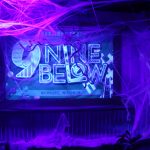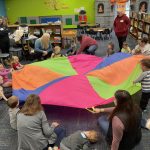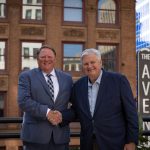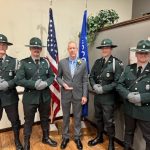2007-09 Vital Source Mag – September 2007
Danbert Nobacon
Danbert Nobacon has earned his place in the canon of well-known unknowns. Kicking around in Leeds since the late ‘70s, Nobacon was a founder and vocalist of Chumbawamba, which though they only had one international radio hit (1997’s “Tubthumping” ) managed to keep the royalties flowing and the tours rolling until the band’s demise in 2004. Now he’s back on Chicago’s Bloodshot Records with a debut solo outing that only a certified veteran could produce. Although the impact of Nobacon’s musical offering is felt upon first listen, it’s also one of those “creepers,” “sleepers” or “seepers” (however you want to word it) wherein the songs and the downright artistry involved only open up after repeated exposure. The rewards are great – almost revelatory – but the extra investment is required to fully appreciate the treasure within. Despite how one might be predisposed to view The Library Book of the World given Chumbawamba’s history, this is not one-hit wonder, get-rich quick, use-once-and-destroy pop music. It’s also not a bludgeon and impale, politicking musical manifesto. It’s artfully layered, full of lyrical twists and turns that include insidious declarations, wholesome ruminations, contemptuous wordplays and, perhaps most of all, damn good music. The arrangements are sparse for the most part, which gives the songs and their subject matter the wind to sail. All in all, it’s the work of a songwriter who is a journeyman at his craft, reaching what he’s after creatively. These are songs for the tavern, both the stage and the bar. And though Danbert’s voice is a bit of an acquired taste, his delivery is impeccable. It seethes with the integrity of conviction, sways with the power of knowledge and soothes with the empathy of experience. There’s an underlying vein of humor throughout the disc, but in the end, what else is there in the face of unrelenting, apathetic ignorance?
Sep 1st, 2007 by Troy ButeroChris Abele
‘Chris Abele’ and ‘Argosy’ may draw blank stares from the average Joe or Jane; ask a local arts supporter, though, and you’ll get a knowing nod. Abele is the 41-year-old head of the Argosy Foundation, established by his father John, co-founder of Boston Scientific, in 1997. The foundation moved from Boston to Milwaukee, where Chris was alerady living, in 2003. Since then, he has generously given his own time and money here and nationwide, supporting the work of groups like Planned Parenthood and the Boys and Girls Club and making appearances at political functions around the world. The Argosy Foundation supports the arts, but its broader mission is to improve the human condition through better access to healthcare, education initiatives for children, environmental protection, improving public safety and more. In the interest of full disclosure, Chris Abele is VITAL’s only financial investor to date, having purchased a (very) minority share of the magazine several years ago. Since then he has made himself scarce, letting us do things however we see fit. He says it’s his way of supporting something he believes in strongly – the enduring relevance of a diverse media. How did the arts become a focus for you? The arts have been part of my life as long as I can remember, largely because I was fortunate enough to grow up in a family who provided plenty of opportunities to experience and learn about music, theater, dance and visual art, [and] shared their passion for it. Our family has supported various arts groups for as long as I can remember. My personal involvement started with the Museum of Fine Art in Boston, but has developed into far more here in Milwaukee. What do you hope to achieve with your contributions of money and time in the arts community? For the groups themselves, I hope to encourage them to strive for ambitious goals; one aspect of Milwaukee that I love is a temperament of relative understatement, which can sometimes mistranslate into diminished expectations of just how much we can achieve and how high we can aim. I would love to see a greater level of pride and celebration of some of the great art that does happen here. For the city writ large, I would love to help people realize just how much we have here and foster a more collective understanding that a life without art is a life deeply diminished. Why is it important to foster the arts at the local level? Our foundation supports arts nationally and internationally, but we are headquartered here in Milwaukee and we believe that part of good corporate citizenship is support for the local community. Personally, I think we have a better arts scene than many people outside Milwaukee imagine, and I’m very excited about how much it continues to grow. What do you consider your greatest achievement as an arts supporter? I’m not sure if it’s for me to declare anything in particular a “great achievement” but I feel good […]
Sep 1st, 2007 by Jon Anne WillowYour papers, please
In August, Lucky and I went to Monterey, California, to visit our dad. We had an amazing time driving the coastal highway through Big Sur, picnicking on a friend’s private beach and cooking like the three of us were still the big Italian family we grew up with. But it wasn’t all just for a lark. My dad’s been sick since last fall, though he didn’t tell us until recently, and all of us are starting to think about the impending “future.” Lucky and I saw my dad in a new light this time: no longer entirely the Pacino-channeling, devastatingly charming, problem-fixing free spirit we grew up with, the man who met us at the door this time was a little too thin, with pure white hair and a big smile that caught me off guard with its open expression of joy at our arrival. In many ways, I like this man better. He’s mortal at last, which probably clears the road for both Lucky and I to look at ourselves and the people we choose in a more realistic way. And even if you’re not into psychoanalysis (sadly, I think it might be a blossoming obsession of my own middle age), it was so nice to be able to really talk to him without the layers of external image that have previously defined him for us. We traveled on relatively short notice, so to save almost $200 per ticket we chose to land in San Jose, then rent a car and drive the 90 minutes to Monterey. For those who’ve never experienced the pleasure of SJC firsthand (though I should note that a renovation is underway), the terminal is the size of a postage stamp and equally useful to air travelers. There’s one bathroom past the secured area – and by that I mean ONE unisex, one-toilet bathroom serving hundreds of people at all times. There’s no place past security to buy water or anything else (and as in airports everywhere, you can’t bring it in with you); there’s one tiny “food court” near the main entrance and it’s a fairly long bus ride to the understaffed rental car building. Needless to say, the security lines were looong, winding the equivalent of several city blocks when we entered the queue to catch our ride back to Milwaukee. We had plenty of time to chat up our fellow travelers, but when the novelty of that wore off after about five minutes, I daringly made eye contact with an attractive black woman in a sharp navy blazer and impossibly well-tailored khakis. She was in a kiosk, positioned under a sign that read “Now You Can Fly Through Airport Security.” The woman was stylishly hawking Clear, a pay service that allows member travelers to expedite airport security checks by whisking through Clear’s own “designated security lane with special benefits,” bypassing the teeming masses and leaving plenty of time to make gratuitous cell phone calls at the gate while waiting for everyone else. […]
Sep 1st, 2007 by Jon Anne WillowRaise the Curtain!
The performing arts season bursts open with a half-dozen theatre groups launching productions this month. The Milwaukee Rep opens no less than three shows, including its centerpiece – Lee Ernst as Cyrano De Bergerac. The Rep’s cabaret opens its season with this year’s Roger Beane show Life Could Be A Dream. In more edgy local theatre, Wisconsin Lutheran College presents a couple of compelling one-acts, including Tickless Time, about the nature of time, and The Illuminati In Drama Liber, an experimental piece that explores the nature of linearity. Further out, Madison’s Mercury Players Theatre presents a comic musical production of Reefer Madness. Also in Madison, The Madison Rep opens its season with Death of A Salesman. Death sings a bit closer to home with The Skylight Opera Theatre’s production of The Midnight Angel. Local stages animate with intense drama as Dramatists Theatre and Milwaukee Shakespeare launch Orpheus Descending and 2 Henry IV respectively, both productions of some pretty heavy work by two of the greatest playwrights in history.
Sep 1st, 2007 by Russ Bickerstaff20 Years in The Life
In a city quickly becoming known for both the abundance and quality of its film festivals, he LGBT Film Festival is one of Milwaukee’s longest running. Once housed solely in the UWM film department and programmed in conjunction with Great Lakes Film and Video (no longer in existence), the festival has grown over time and now incorporates the efforts of the Peck School of the Arts – UWM’s visual arts, dance and theatre department. Now in its 20th year, the LGBT Film Festival is no longer just a community tradition; it has become a showcase for some of the finest films and videos from and about the lesbian, gay, bisexual, and transgender communities. The LGBT Film Festival started in 1987 to address the lack of representation of gay, lesbian, bisexual and transgender people on screen. Its growth in popularity can be attributed in part to the boom of the independent film market and a greater general awareness of the LBGT community. But its long-running success has been achieved through consistently providing a well-run event offering an excellent balance of thought-provoking and entertaining films. The process of putting on an 11-day film festival takes planning – weeding through film submissions, making contacts and solicitations, researching and attending other gay and lesbian film festivals and reviewing old films. And while the festival itself has gotten bigger, making it happen still falls, as it has for the last decade, upon one man: Carl Bogner. As an undergraduate student in the film department at UWM in the mid ‘90s, Carl ran the Union Theater. After receiving his film degree, he was asked by Dick Blau, then Chair of the UWM Film Department, to take over the festival. Now in his 10th year with the event, Carl has seen the festival grow to hit more notes on the cinematic scale. It has become a textured body, striking a perfect balance of audience-pleasing films and more challenging and academic works. Carl sees the growth of the LGBT Film Festival, and the gay community in general, from a generational perspective. The younger gay and lesbian demographic are “just cooler.” He continues, “I don’t mean to say they have it easier, but it’s a wonderfully different attitude associated with identity than, say, people my age.” One factor is the lack of labels or cultural taboos that many of the younger generation of gay and lesbians associate with, most notable being the trauma of “coming out,” which has been, until recently, a staple of gay and lesbian film festivals. “For younger people, gays and lesbian film festival have a different kind of weight and interest. I don’t think they feel like they don’t have access to gay and lesbian images the way early generations did,” Carl explains. Finding the one perfect film for opening night that serves the diverse LGBT community can be a challenge. This year’s festival will open on September 6 at the Oriental Theater with Nina’s Heavenly Delights, from pioneering filmmaker and scholar Pratibha Parmar. Described […]
Sep 1st, 2007 by Blaine Schultz“If only we could pull out our brain and use only our EYES.” — Pablo Picasso
The human eyes are small but wondrous – a pair of infinitely complex sensors that allow us to experience wavelengths of light as fully formed, instantaneous impressions of color, shape and depth. The nerves and cells in the eye are some of the body’s most sensitive, the muscles that allow the eyes to move the most rapid. Even in sleep, when our eyes are closed, their rapid motion allows us to dream. And they are beautiful – shiny and variegated, an object of poetry, curiosity, perhaps even a window into the soul. And never are the eyes put to better use than to witness beauty, to drink in sights previously unseen and thereby engender a deeper understanding that enriches the soul. Test the soul-altering power of your eyes in September by taking in the universe as Villa Terrace presents a collection of Renaissance star charts and maps of the cosmos. The Racine Art Museum, one of the nation’s foremost craft museums, explores the beauty of shoes with Icons of Elegance, the first exhibition in North America to pair the most important shoes of the 1900s with the history of modern design. At the Tory Folliard Gallery, in the first solo Tom Uttech exhibition since his 2004 retrospective, you can see awe-inspiring elements of the natural and the fantastical. Turn your gaze into the past and see how it shaped the present at the Milwaukee Art Museum with Foto, a winter exhibition of radically modern photography from Central and Eastern Europe in the years between World Wars. Squint and you’ll pierce the dark veil of winter to focus on the delicate consequences of cross-cultural communication at MIAD with This Land is Your Land, a diverse group of shows about boundaries, shifts and perspectives. In the spring let your eyes roam over interpretations of the urban landscape we navigate every day with a group show at the Katie Gingrass Gallery featuring work in sculpture, neon and photography, or get a visual sense of the 19th century at the Haggerty Museum of Art with an exhibition of illustrations from Harper’s.
Sep 1st, 2007 by Amy Elliott“Keep guard over your EYES AND EARS as the inlets of your heart …” — Anne Bronte
The percussion of two eyelids meeting during a blink is not audible to the human ear, which consists of fibro-elastic cartilage covered with skin and fine hairs. In contrast to the eyes, the ears are always working. Visual reality is limited to a single, blinking field of vision and sight requires the tireless work of the ears to give it direction. Thus sight is aided by the ears, but rarely are the two given equal attention onstage. The Milwaukee Symphony Orchestra will address the disparity between sight and hearing this season by presenting two concerts featuring music written specifically for the eyes. In April, the MSO performs the score to Charlie Chaplin’s City Lights as the film is projected overhead at The Marcus Center. Earlier on, the MSO will perform a special Halloween concert featuring scores written for Alfred Hitchcock films. Hitchcock worked with such influential film composers as Bernard Hermann, Dimitri Tiomkin and Franz Waxman, so this could be profoundly good. The work of another composer who wrote largely for the eye will be included on a concert at the Wilson Center in September as visually appealing Grammy-nominated vocalist Monica Mancini performs on the 15th. Included will be songs written by her father Henry, who wrote scores for over a hundred films in his lifetime (The Glenn Miller Story, Breakfast at Tiffany’s, The Pink Panther ). Monica will perform some of her father’s songs (such as “Moon River” and “Dear Heart” ) to clips of the films in which they appeared. In the realm of more contemporary film music, The Waukesha Symphony Orchestra will present Corigliano’s Suite for Violin and Orchestra from his Academy Award-winning score to The Red Violin. The WSO will be joined by American virtuoso Maria Bachman – one of Corigliano’s favorite violinists. In a similar hybrid of film and music, The Skylight Opera closes its season with Nine: The Musical. Written by Maury Yeston and Arthur Kopit, this Broadway hit is an oddly skewed adaptation of film legend Frederico Fellini’s autobiographical masterpiece 8½. The musical adaptation of Fellini’s highly surrealistic and self-referential film may seem like something of a curiosity, but the show was a big hit on Broadway. The Skylight has a flair for putting together visually appealing presentations, so it will be interesting to see how they render what should prove to be a very interesting evening of musical theatre.
Sep 1st, 2007 by Russ Bickerstaff















